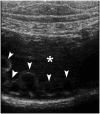Primary intestinal lymphangiomatosis of the ileum in an adult-the role of surgical approach
- PMID: 27534888
- PMCID: PMC4988297
- DOI: 10.1093/jscr/rjw133
Primary intestinal lymphangiomatosis of the ileum in an adult-the role of surgical approach
Abstract
Lymphangioma is a rare benign tumor that occurs due to abnormalities occurring during lymphatic development. It is usually seen in children and young adults. The incidence of lymphangiomas in the gastrointestinal tract is very low. Here we describe the case of 43-year-old woman with lymphangioma of the ileum with infiltrative polyposis-like appearing lesions diagnosed by capsule endoscopy and treated with segmental resection of affected intestinal part with laparotomy. Lesions involving mesentery and ileum were confirmed by pathology. After surgery, the patient's symptoms improved. No further therapy was needed because of the benign manner of the lesions. Patient had no symptoms in 10 months follow-up after surgery.
Published by Oxford University Press and JSCR Publishing Ltd. All rights reserved. © The Author 2016.
Figures




References
-
- Blei F. Lymphangiomatosis: clinical overview. Lymphat Res Biol 2011;9:185–90. - PubMed
-
- Takami A, Nakao S, Sugimori N, Ishida F, Yamazaki M, Nakatsumi Y, et al. . Management of disseminated intra-abdominal lymphangiomatosis with protein-losing enteropathy and intestinal bleeding. South Med J 1995;88:1156–8. - PubMed
-
- Losanoff EJ, Richman BW, El-Sherif A, Rider KD, Jones JW. Mesenteric cystic lymphangioma. J Am Coll Surg 2003;196:598–603. - PubMed
-
- Bellini C, Hennekam RC. Clinical disorders of primary malfunctioning of the lymphatic system. Adv Anat Embryol Cell Biol 2014;214:187–204. - PubMed
Publication types
LinkOut - more resources
Full Text Sources
Other Literature Sources

